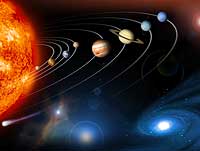|
Earn up to ₹40 per post as scholarship. Unlimited earning potential per month. |
 It is said that Newton wanted to calculate the exact distance between the Earth and Sun as an astronomical unit but unfortunately the transit did not happen in his lifetime. Such is the importance of this celestial event. We are a lucky lot to witness this great celestial event called the “Venus Transit” which is scheduled to occur on June 6 and it can be watched from India from 5.31 am to 10.22 am. The next transit would occur only after 105.5 years on December 11, 2117, so it may be the last and only chance for all the living human as on today.
It is said that Newton wanted to calculate the exact distance between the Earth and Sun as an astronomical unit but unfortunately the transit did not happen in his lifetime. Such is the importance of this celestial event. We are a lucky lot to witness this great celestial event called the “Venus Transit” which is scheduled to occur on June 6 and it can be watched from India from 5.31 am to 10.22 am. The next transit would occur only after 105.5 years on December 11, 2117, so it may be the last and only chance for all the living human as on today.
What is a Transit?
The phenomenon is similar to the Solar eclipse in which Moon comes between the Earth and Sun and makes the Sun dark. However, Transit involves Mercury or Venus come between the Earth and the Sun. The Sun may not be completely darkened as in the case of Solar eclipse as the distance of the Mercury or Venus is very large as compared to the distance between Earth and the Moon, so these planets would just appear as a dark dot on the disc of the Sun as it moves across it.
The frequency of transit of the Mercury is 13-14 times in a century and so much common against the transit of Venus which occurs only after more than a century. So the transits of Venus across the disc of the Sun are among the rarest of the planetary alignments. In fact only 7 have been witnessed by the human after invention of the telescope.
The transit are of significance to astronomy scientists as much as to the students of astronomy and astrophysics and astronomers as it helps in calculating the distance between the Earth and Sun and all planets.
How to watch
- Project the image seen through the telescope on a screen or a wall.
- Small telescopes or binoculars can be used to project the image.
- Use a small wall mirror to project the image on a screen. An image of 1-1.5 inches can be seen if the mirror is placed at a distance of about 30 cm.
- Direct viewing may be done using only approved solar filters which may be used to cover the telescope view port.
- Use approved welding glass (number 14 and 16).
- View intermittently even with the approved filters as said above.
Dont’s
- Don’s attempt to watch it with naked eye directly or through telescope.
- Don’t use X-ray film
- Don’t watch it as image in water, which is equivalent to watching directly.
- Don’t see it through smoked glass, sunglasses or any Polaroid glasses.